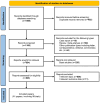Efficacy of neoadjuvant, adjuvant, and perioperative immunotherapy in non-small cell lung cancer across different PD-L1 expression levels: a systematic review and meta-analysis
- PMID: 40463367
- PMCID: PMC12129973
- DOI: 10.3389/fimmu.2025.1569864
Efficacy of neoadjuvant, adjuvant, and perioperative immunotherapy in non-small cell lung cancer across different PD-L1 expression levels: a systematic review and meta-analysis
Abstract
Background: Immune checkpoint inhibitors, particularly anti-PD-1/PD-L1 monoclonal antibodies, have transformed non-small cell lung cancer (NSCLC) treatment. This meta-analysis evaluates the efficacy of neoadjuvant, adjuvant, and perioperative immunotherapy in resectable NSCLC, stratified by PD-L1 expression levels.
Methods: We conducted a meta-analysis of 10 randomized controlled trials (RCTs) involving 11 articles, focusing on pathological complete response (pCR), major pathological response (MPR), event-free survival (EFS), and overall survival (OS). These outcomes were stratified by PD-L1 expression levels (<1%, ≥1%, 1-49%, ≥50%).
Results: Immunotherapy significantly improved pCR (OR=4.96, 95% CI=2.88-8.57 for PD-L1<1%; OR=9.58, 95% CI=6.32-14.53 for PD-L1≥1%), MPR (OR=2.86, 95% CI=1.97-4.16 for PD-L1<1%; OR=7.39, 95% CI=4.59-11.88 for PD-L1≥1%), and EFS (HR=0.80, 95% CI=0.70-0.92 for PD-L1<1%; HR=0.53, 95% CI=0.45-0.62 for PD-L1≥1%) across all PD-L1 subgroups. Greatest benefits were observed in PD-L1≥50% subgroup, with ORs for pCR and MPR, and HRs for EFS, showing consistent improvements. OS benefits were significant in PD-L1≥1% patients (HR=0.62, 95% CI=0.49-0.79 for PD-L1≥1%) but uncertain in PD-L1<1% cohorts (HR=1.11, 95% CI=0.86-1.44 for PD-L1<1%). Immunotherapy in perioperative setting demonstrated robust efficacy, with significant pathological response and EFS benefits across all PD-L1 subgroups.
Conclusion: This meta-analysis supports immunotherapy within perioperative care for resectable NSCLC, emphasizing PD-L1 expression as a predictive biomarker. Future studies should optimize patient selection and clarify immunotherapy's role in different treatment settings.
Systematic review registration: https://www.crd.york.ac.uk/PROSPERO/view/CRD42025644497, identifier CRD42025644497.
Keywords: PD-L1 expression; efficacy; immunotherapy; meta-analysis; non-small cell lung cancer.
Copyright © 2025 Zhang, Lin and Chen.
Conflict of interest statement
The authors declare that the research was conducted in the absence of any commercial or financial relationships that could be construed as a potential conflict of interest.
Figures





Similar articles
-
Efficacy and safety of immune checkpoint inhibitors as neoadjuvant therapy in perioperative patients with non-small cell lung cancer: a network meta-analysis and systematic review based on randomized controlled trials.Front Immunol. 2024 Oct 1;15:1432813. doi: 10.3389/fimmu.2024.1432813. eCollection 2024. Front Immunol. 2024. PMID: 39416776 Free PMC article.
-
Identifying patients who benefit more from perioperative immunotherapy combinations for resectable non-small cell lung cancer based on clinical and molecular characteristics: a meta-analysis of randomized clinical trials.Clin Transl Oncol. 2025 Apr;27(4):1516-1528. doi: 10.1007/s12094-024-03712-0. Epub 2024 Sep 12. Clin Transl Oncol. 2025. PMID: 39264530
-
The efficacy and safety of neoadjuvant immunochemotherapy in resectable stage I-III non-small cell lung cancer: a systematic review and network meta-analysis.Clin Transl Oncol. 2025 Apr;27(4):1493-1505. doi: 10.1007/s12094-024-03704-0. Epub 2024 Sep 9. Clin Transl Oncol. 2025. PMID: 39251495
-
The Value of Perioperative Immunotherapy for Non-Small Cell Lung Cancer: A Pool- and Meta-Analysis.Technol Cancer Res Treat. 2024 Jan-Dec;23:15330338241258164. doi: 10.1177/15330338241258164. Technol Cancer Res Treat. 2024. PMID: 38872482 Free PMC article.
-
Efficacy and safety of perioperative immunotherapy combinations for resectable non-small cell lung cancer: a systematic review and network meta-analysis.Cancer Immunol Immunother. 2024 Oct 9;73(12):262. doi: 10.1007/s00262-024-03844-w. Cancer Immunol Immunother. 2024. PMID: 39382658 Free PMC article.
Cited by
-
The Utility of Immune Checkpoint Inhibition in the Management of Resectable Non-Small Cell Lung Cancer.Cancers (Basel). 2025 Jul 25;17(15):2462. doi: 10.3390/cancers17152462. Cancers (Basel). 2025. PMID: 40805162 Free PMC article. Review.
-
Efficacy of adjuvant therapy regimens administered during the perioperative period in resectable non-small cell lung cancer.Cancer Immunol Immunother. 2025 Sep 1;74(9):296. doi: 10.1007/s00262-025-04159-0. Cancer Immunol Immunother. 2025. PMID: 40888897 Free PMC article.
References
Publication types
MeSH terms
Substances
LinkOut - more resources
Full Text Sources
Medical
Research Materials

